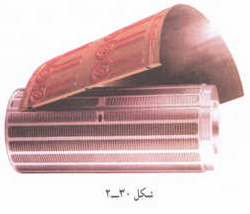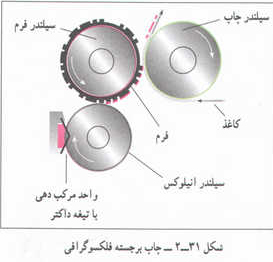Lesson One
Printing Industry
Printing Industry encompasses numerous fields of every economy. Printing Industry generates a
wide range of products which require in every step of our everyday life.
Newspapers, Magazines, Books, Post Cards and Business Order Forms each are the products of
Printing Industry.
Other than the direct contributions, there are many indirect influences of Printing Industry up on
the economy. This is because, all the activities like Binding, Embossing which generate
considerable amount of income and employment are related closely with the Printing Industry.
Packaging industry and Advertising Industry in many ways depend on the Printing Industry.
In the Printing Industry, the main Printing Techniques that are used are:
Lithography-This technique emphasizes on economical use of color. Used for printing
magazines, catalogues, books and metal cans.
Flexography- This technique produces vibrant colors and is used for printing newspapers,
books flexible packaging and labels.
Gravure-This technique is famous for Print Quality and Print Formats and is mainly used for
product printing to be used in packaging industry.
Letterpress-This technique is used when printing is done on raised surfaces. (Stationary,
packaging, plastic containers and newspapers)
Screen Printing-This technique is mainly used to print designs on fabrics, ceramics, signs,
bottles and electronics.
Each printing process includes three basic steps: preparing an image carrier; transferring the
image, either directly or indirectly onto the substrate to be printed; and finishing. The finishing
steps will differ depending upon the printing process. For example, lithographic printed materials
may be folded, trimmed, collated, laminated, die cut, or embossed, depending on the function of
the final product.
But it is very important to mention that the Printing Industry all over the world are experiencing
high level of technical advancement and there is no doubt that all these research and
development works are contributing immensely to the growth of Printing Industry across the
world.
Printing Industry Growth
Printing Industry Growth is an outcome of different actions and reactions which took place in
past few decades all over the world. In most of the cases, growth of any industry is driven by the
increase in demand. The Printing Industry is no exception. The Growth of Printing Industry has
taken place due to rising demands for printed products. Now if we want to find the reason behind
3
this increase in demand we will find several factors. Among these, the main factors are Overall
Economic Growth, Population Growth, Increasing Advertising Expenditures and the Advent of
Internet.
Printing Industries of America
Printing Industries of America hold a vital position in the economy of U.S.A. Printing Industry
generates large volume of employment in U.S and can be ranked first in terms of economic
output.
The U.S Printing Industry comprises of thousands of small Printing Units which employ more
than 1 million people. The industry is able to produce $100 billion in every year.
But, the major concern of U.S Printing Industry which is generating negative impact is the
Chemical Waste Problem. This problem of Waste management is posing a question to economic
viability and survival of the printing industry.
Gravure printing machine
Offset printing machine
4
Please answer the following questions:
1- Which one of the following items are the products of the Printing Industry?
A. Magazines, Newspapers.
B. Books and business forms.
C. Magazines and Postcards.
D. A, B and C.
2- According to test, what industries depend on Printing Industry?
A. Packaging and Steel Industries.
B. Advertising and Packaging Industries.
C. Automobile and Aircraft Industries.
D. None of the above.
3- The main printing techniques are:
A. Pre press and press.
B. Digital printing, Gravure and binding.
C. Lithography, Flexography, Screen printing, Letter press and Gravure.
D. A, B and C.
4- “The Growth of Printing Industry has taken place due to:
A. Low cost for running a printing house.
B. Population growth.
C. Rising demand for printed products.
D. Good economic situation.
5- What are the factors for increase in demand of print products?
A. People like to see better products.
B. Economic and Population growth.
C. Increase in Advertisement cost and Internet advent.
D. B and C.
5
Vocabulary:
Encompass Growth
Field Supply
Binding Demand
Embossing Advertising
Lithography Population
Flexography Factors
Gravure Chemicals
Letterpress Waste
Screen printing Management
Print quality Sheet fed
Economy Web (Roll)
Surface Prepress
Fabric Press
Packaging Post press
Folding Finishing
Trimming Die cut
Laminate Water hardness
Collate pH value
Advancement Set-off
Development Alkaline
6
Lesson Two:
Offset Printing
Offset printing is a commonly used printing technique where the inked image is transferred (or
"offset") from a plate to a rubber blanket, then to the printing surface. When used in combination
with the lithographic process, which is based on the repulsion of oil and water, the offset
technique employs a flat (planographic) image carrier on which the image to be printed obtains
ink from ink rollers, while the non-printing area attracts a water-based film (called "fountain
solution"), keeping the non-printing areas ink-free.
History
Lithography was initially created to be a low cost method of reproducing artwork. This printing
process was limited to use on flat, porous surfaces because the printing plates were produced
from limestone.
Compared to other printing methods, offset printing is best suited for cost-effectively producing
large volumes of high quality prints in an economically sound manner that requires little
maintenance.
Applications
Offset lithography is one of the most common ways of creating printed matter. A few of its
common applications include: newspapers, magazines, brochures, stationery, and books.
Many modern offset presses use computer to plate systems as opposed to the older computer to
film workflows, which further increases their quality.
Advantages
Advantages of offset printing compared to other printing methods include:
• Consistent high image quality. Offset printing produces sharp and clean images and type
more easily than letterpress printing .
• Quick and easy production of printing plates.
• Longer printing plate life than on direct litho presses because there is no direct contact
between the plate and the printing surface.
• Cost. Offset printing is the cheapest method to produce high quality printing in
commercial printing quantities.
7
Disadvantages
Disadvantages of offset printing compared to other printing methods include:
• Slightly inferior image quality compared to rotogravure printing.
• Propensity for anodized aluminum printing plates to become sensitive (due to chemical
oxidation) and print in non-image/background areas when developed plates are not cared
for properly.
• Time and cost associated with producing plates and printing press setup. As a result, very
small quantity printing jobs are now moving to digital offset machines.
There are three main cylinders in litho
offset printing:
1- Plate cylinder
2- Offset (blanket) cylinder
3- Impression cylinder
Side view of the offset printing process. Multiple ink rollers are used to distribute the ink.
8
Please answer the following questions:
1- Offset printing is a technique where:
A. Sheet fed machines are used.
B. Web machines are used.
C. Inked image is transferred from a plate to a rubber blanket.
D. Inked image is transferred directly to the paper.
2- In offset printing, image to be printed obtains ink from:
A. Ink factories.
B. Damping rollers.
C. Pressure cylinder.
D. Ink rollers.
3- The early printing plates were made of:
A. Wood.
B. Limestone.
C. Aluminum.
D. Zink.
4- Which of the following is an advantage for Offset printing?
A. Quick and easy production of printing plates.
B. Time and cost associated with producing plates and printing press setup.
C. Longer printing plate life than on direct litho presses.
D. A and C.
5- In an offset printing machine paper moves between:
A. Ink rollers and plate cylinder.
B. Plate cylinder and rubber blanket.
C. Offset cylinder (blanket cylinder) and impression cylinder.
D. None of the above.
9
Vocabulary:
Ink rollers Stationary
Damping rollers CtP
Rubber blanket CtF
Planography Workflow
Water based film Consistent
Area Humidity
Attract Printing surface
Ink free Substrate
Low cost method Commercial Printing
Flat Inferior
Limestone Compared to
Porous (none porous) Set-off
Fountain solution Print area
Volume Background
Maintenance Press set up
Application Impression cylinder
Advantage Plate cylinder
Disadvantage Conventional plate
Newspaper Hydrophobic
Magazine Hydrophilic
10
.:
ادامه مطلب :.
نوشته : محمد اربابی
تاریخ: شنبه 5 شهريور 1390برچسب:صنعت چاپ درس 1,Printing Industry ,magazines,catalogues,Advertising Industry,technique,packaging industry,Folding , Die cut ,,






